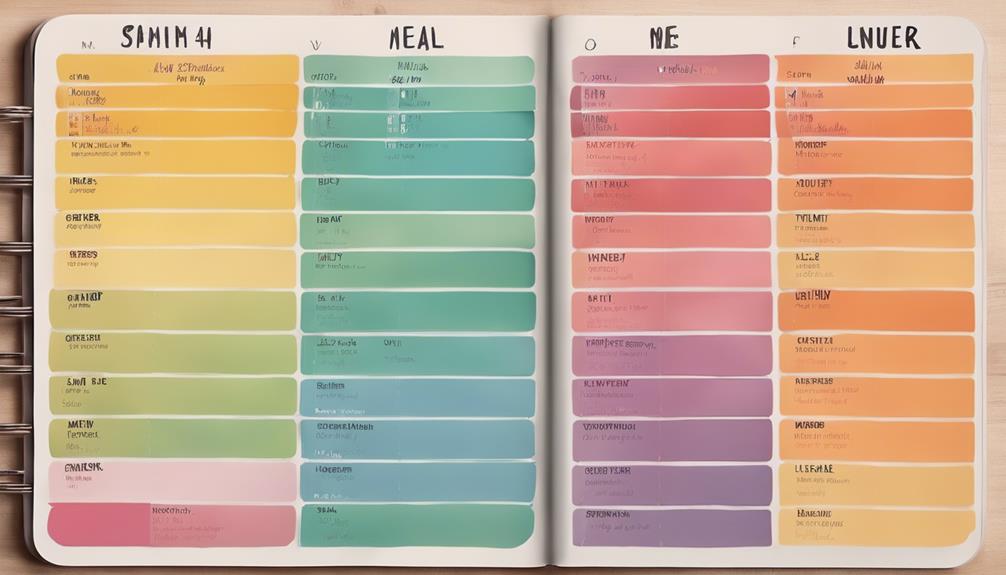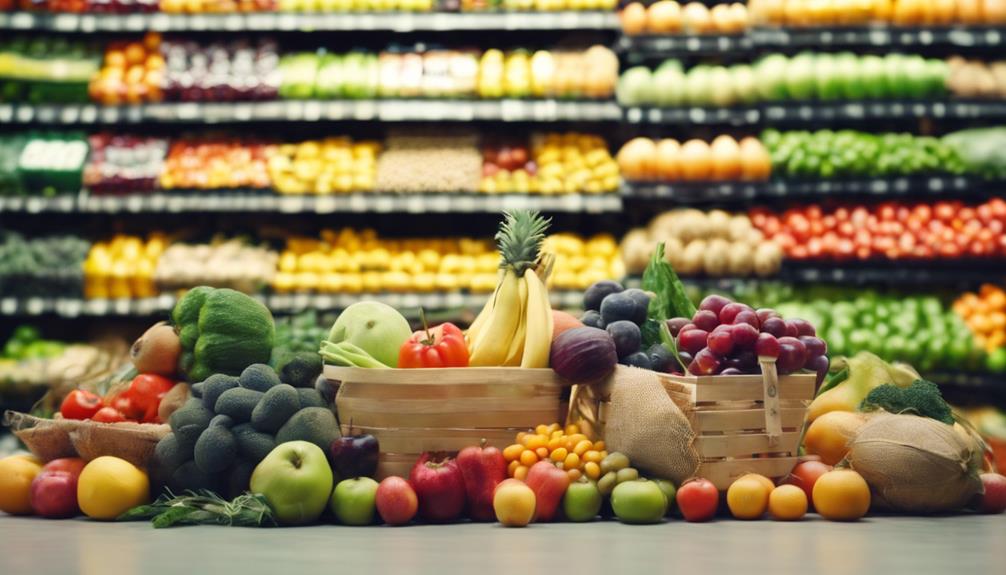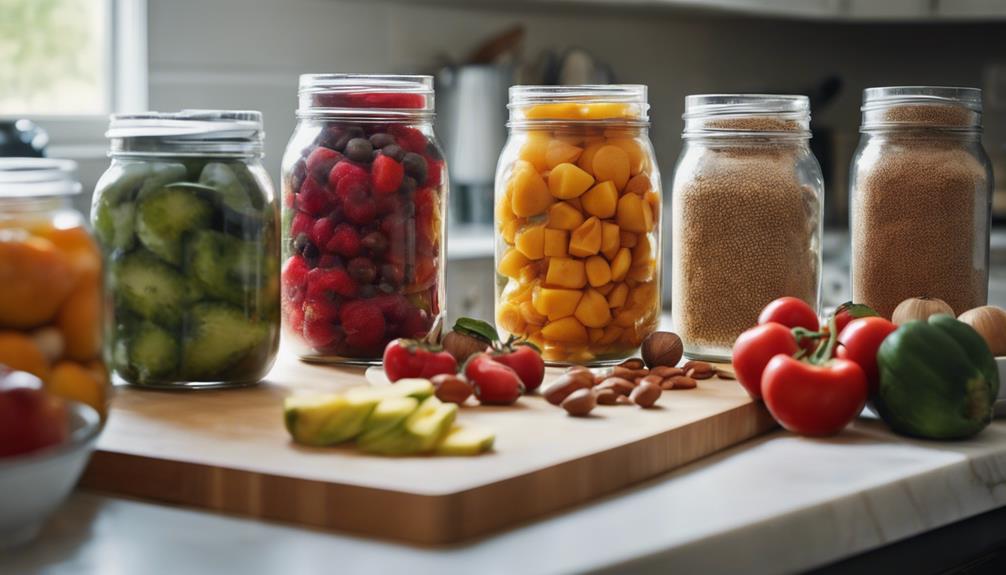Strategies for Healthy Eating on a Budget
Navigating the landscape of affordable, nutritious eating can be like embarking on a culinary puzzle – a quest to strike the perfect balance between health-conscious choices and budget-friendly options.
As you ponder the aisles of your local grocery store, wondering how to make the most of your resources without compromising on well-being, a roadmap of strategies awaits.
From clever meal planning to tapping into community resources, there are secrets to uncover that can revolutionize your approach to eating well without breaking the bank.
Key Takeaways
- Organize pantry and plan meals efficiently for budget-friendly healthy eating.
- Utilize bulk buying benefits for cost-effective meal preparation and easy access to ingredients.
- Prioritize seasonal produce for freshness, flavor, and affordability in nutritious meals.
- Opt for affordable protein sources and superfoods, DIY snacks, and utilize coupons for savings.
Meal Planning
When aiming to eat healthily on a budget, meal planning is a crucial step that can help you save money and make nutritious choices. Start by organizing your pantry to easily see what ingredients you have on hand. This can prevent unnecessary purchases and reduce food waste. Time-saving tips like preparing meals in batches or using a slow cooker can make healthy cooking more manageable.
For budget-friendly substitutions, consider using dried beans instead of canned ones. They're cheaper and can be just as nutritious when cooked properly. Opt for frozen fruits and vegetables, which are often more affordable than fresh produce and retain their nutrients well. Incorporate whole grains like brown rice and oats, which are cost-effective and packed with essential nutrients.
Nutrition hacks include using herbs and spices to add flavor without relying on salt or high-fat condiments. They can elevate your meals while providing health benefits. Additionally, choose lean cuts of meat or plant-based proteins like lentils to reduce costs while still meeting your protein needs. By meal planning and incorporating these strategies, you can eat healthily without breaking the bank.
Smart Shopping Tips
To make the most of your budget while maintaining a healthy diet, implementing smart shopping tips is essential for optimizing your grocery choices and ensuring you get the best value for your money.
- Plan Ahead: Before heading to the store, create a shopping list based on budget-friendly recipes and healthy swaps. This will prevent impulse buys and keep you focused on necessities.
- Check for Sales and Coupons: Keep an eye out for discounts, sales, and coupons on healthy staples. Buying items on sale or with coupons can significantly lower your grocery bill.
- Shop Seasonally: Opt for seasonal fruits and vegetables as they tend to be cheaper and fresher. Incorporating seasonal produce into your meals can add variety to your diet while saving you money.
- Compare Prices: Don't settle for the first option you see. Compare prices between brands and sizes to get the best deal. Sometimes, the generic or store-brand item is just as good as the more expensive one.
Bulk Buying Benefits
Bulk buying offers significant benefits for both your wallet and your pantry, allowing you to save money and stock up on essential items for your healthy eating journey. When you buy in bulk, you can take advantage of lower prices per unit, which can result in substantial savings over time. Additionally, having a well-stocked pantry can help you avoid last-minute trips to the store, saving you both time and money.
Pantry organization plays a crucial role when buying in bulk. Make sure to arrange your pantry in a way that allows you to see and access items easily. Consider using clear containers for bulk items like grains, nuts, and dried fruits to keep them fresh and visible. Proper organization not only helps you know what you have on hand but also encourages meal prep and planning.
Meal prep is another key advantage of bulk buying. When you have ingredients readily available in your pantry, meal prep becomes more convenient and efficient. You can prepare larger batches of meals in advance, saving time during busy weekdays and ensuring you always have healthy options at your fingertips. By incorporating bulk buying into your routine, you can streamline your pantry organization, enhance your meal prep, and ultimately support your journey to healthy eating on a budget.
Seasonal Produce Advantage
Arranging your pantry strategically not only facilitates bulk buying but also sets the stage for maximizing the advantages of incorporating seasonal produce into your healthy eating routine. When you prioritize seasonal fruits and vegetables, sourced from local farms or farmers markets, you not only support your community but also enjoy numerous benefits:
- Freshness: Seasonal produce is typically harvested at its peak, ensuring optimal flavor and nutrient content.
- Cost-Effectiveness: Due to the abundance of seasonal fruits and vegetables, prices are often lower, allowing you to get more for your money.
- Variety: Each season brings a different array of produce, encouraging culinary creativity and a diverse nutrient intake.
- Environmental Impact: By choosing seasonal produce from local sources, you reduce the carbon footprint associated with long-distance transportation.
Cooking in Batches
When looking to optimize your time and resources in the kitchen, consider embracing the strategy of batch cooking for a more efficient and cost-effective approach to meal preparation. Batch cooking involves preparing larger quantities of food at once and then storing portions for later consumption. This method not only saves time but also helps in portion control, ensuring you have healthy meals readily available when you need them.
| Benefits of Batch Cooking | Description |
|---|---|
| Time Management | Batch cooking allows you to prepare meals in advance, saving time during busy weekdays. |
| Portion Control | By dividing meals into individual portions, you can easily manage serving sizes, preventing overeating. |
| Cost-Effective | Buying ingredients in bulk for batch cooking can be more economical than purchasing single servings. |
| Reduced Stress | Having pre-cooked meals ready reduces daily meal-prep stress, making it easier to stick to your healthy eating goals. |
Reduce Food Waste
To further maximize your efficiency in the kitchen and make the most of your ingredients, let's address the importance of reducing food waste.
- Practice portion control and meal prep: By planning your meals and portioning ingredients accordingly, you can reduce the likelihood of having excess food that may go to waste. Meal prepping also helps you utilize ingredients more efficiently, making it easier to stick to your budget.
- Utilize freezer storage: If you have leftovers or ingredients that you may not use before they spoil, consider freezing them. Freezing can help extend the lifespan of many foods, allowing you to use them at a later time when you're ready.
- Repurpose leftovers: Instead of throwing out leftovers, get creative with how you can use them in new dishes. For example, leftover roasted vegetables can be added to salads or turned into a flavorful soup, reducing waste while adding variety to your meals.
- Stay mindful of expiration dates: Keep track of the expiration dates of your perishable items and plan your meals accordingly to ensure everything gets used before it goes bad.
Plant-Based Protein Sources
To incorporate a variety of essential nutrients into your diet while keeping costs in check, explore the array of plant-based protein sources readily available. Protein alternatives like beans, lentils, and chickpeas aren't only cost-effective but also versatile in recipes. These budget-friendly protein options can be used as substitutions for meat in dishes like soups, salads, and stews, providing a substantial amount of protein without breaking the bank.
Additionally, tofu and tempeh are excellent sources of plant-based protein that can be included in stir-fries, sandwiches, or as meat substitutes in main courses. They're often more affordable than animal proteins and offer a healthy dose of protein per serving.
Nuts and seeds are another great way to boost your protein intake without spending a lot. Incorporating almonds, chia seeds, or pumpkin seeds into your meals or snacks can add not only protein but also healthy fats and fiber, making them a nutritious and budget-conscious choice for plant-based protein sources.
Affordable Superfoods
For those seeking to enhance their diet with nutrient-dense options that won't break the bank, consider exploring affordable superfoods.
- Quinoa: This ancient grain isn't only packed with protein but also contains essential amino acids, making it a complete protein source that's budget-friendly.
- Sweet Potatoes: Rich in vitamins, minerals, and fiber, sweet potatoes are a nutrient-dense choice that can be a versatile and affordable addition to your meals.
- Canned Salmon: A cost-effective way to incorporate omega-3 fatty acids and protein into your diet, canned salmon is a convenient superfood option.
- Frozen Berries: These budget-friendly options are loaded with antioxidants, fiber, and vitamins, making them a great addition to smoothies, oatmeal, or yogurt.
DIY Snacks and Meals
Consider preparing your own snacks and meals to not only save money but also have full control over the ingredients you consume. Making your own quick bites and snack hacks can be a fun and cost-effective way to eat healthily. Here are some simple ideas to get you started:
| Quick Snacks | Meal Prepping | Snack Hacks |
|---|---|---|
| Fresh fruit slices | Grilled chicken salads | Veggie sticks with hummus |
| Greek yogurt with honey | Quinoa bowls | Trail mix with nuts and seeds |
| Rice cakes with almond butter | Lentil soups | Energy balls made with dates |
| Cottage cheese and berries | Stir-fries | Homemade granola bars |
Couponing for Healthy Options
When looking to save money on healthy food options, leveraging coupons can be a practical and effective strategy. By using discounts and deals, you can make organic options more affordable while still nourishing your body with quality ingredients.
Here are some tips to help you make the most of couponing for healthy choices:
- Subscribe to Coupon Websites: Sign up for newsletters from discount grocery stores and organic food brands to receive exclusive coupons directly in your inbox.
- Utilize Cash-Back Apps: Take advantage of cash-back apps that offer rebates on organic products after purchase, helping you save money in the long run.
- Check Store Flyers: Keep an eye on store flyers for sales on organic items, and combine these discounts with coupons for extra savings.
- Join Loyalty Programs: Many stores offer loyalty programs that provide additional discounts and coupons for organic and healthy products, saving you money on your grocery bill.
Budget-Friendly Recipe Swaps
Looking to stretch your grocery budget further while still enjoying nutritious meals? One effective strategy is to make budget-friendly recipe swaps that can help you save money without compromising on taste or nutrition. By utilizing pantry staples creatively and making simple ingredient swaps, you can create delicious and healthy meals while keeping costs down.
To start, take a look at your pantry staples such as rice, beans, canned tomatoes, and whole grains. These versatile ingredients form the base of many budget-friendly meals. Consider making dishes like bean chili, rice and bean burritos, or a hearty bean and vegetable soup. These meals aren't only affordable but also packed with nutrients.
When it comes to ingredient swaps, get creative with substituting expensive ingredients for more affordable alternatives. For example, swap out expensive meats for beans or lentils in dishes like tacos or casseroles. You can also use frozen vegetables instead of fresh ones to save money without sacrificing nutritional value. By being mindful of your ingredient choices and making smart swaps, you can create budget-friendly meals that are both delicious and nutritious.
Community Resources and Programs
To access additional support for maintaining a healthy diet within budget constraints, explore local community resources and programs that offer assistance and guidance. Here are some ways community resources can help you achieve your goal:
- Food Pantries and Farmer's Markets: These are excellent sources of fresh produce and pantry staples at reduced prices or sometimes even for free. Take advantage of these options to access nutritious foods without straining your budget.
- Cooking Classes and Nutrition Education: Many communities offer cooking classes and workshops focused on healthy eating and budget-friendly meal preparation. These resources can teach you valuable skills to make the most out of your ingredients and create delicious, nutritious meals without breaking the bank.
- Community Gardens: Engaging with community gardens can provide you with a sustainable source of fresh produce at minimal cost. It's also a great way to connect with your community and enjoy the benefits of homegrown fruits and vegetables.
- Local Community Centers: Community centers often host events, workshops, and programs related to healthy eating. These can include nutrition seminars, cooking demonstrations, and support groups, all of which can help you stay on track with your healthy eating goals while on a budget.
Frequently Asked Questions
Are There Any Specific Budget-Friendly Kitchen Gadgets or Tools That Can Help With Healthy Meal Preparation?
You can enhance your meal prep with budget-friendly appliances like a slow cooker or a blender. These tools can save time and money while helping you create healthy dishes effortlessly. Pair them with simple meal prep hacks for efficiency.
How Can I Incorporate More Variety Into My Meals While Still Sticking to a Budget?
To add variety to your meals while sticking to a budget, focus on incorporating different herbs and spices for flavor, experimenting with new grains and legumes, and trying out budget-friendly recipes from diverse cuisines.
Are There Any Affordable Options for Purchasing Organic Produce or Ingredients?
Looking for affordable options to buy organic produce or ingredients? Check out farmers markets for fresh, local, and often cheaper organic items. Community gardens can also provide opportunities to access organic produce at a lower cost.
How Can I Avoid Feeling Deprived or Restricted While Following a Healthy Eating Plan on a Budget?
To avoid feeling deprived while following a healthy eating plan on a budget, focus on mindful indulgences that are guilt-free. Find balance by incorporating foods you enjoy in moderation, ensuring satisfaction and freedom from restriction.
Are There Any Tips for Managing Portion Control and Avoiding Overeating When Trying to Eat Healthily on a Budget?
Focus on mindful eating. Tune into hunger cues and savor each bite. Control portions by using smaller plates. Opt for budget-friendly snacks like fruits, veggies, or nuts. Choose whole foods over processed alternatives for healthier and more satisfying meals.
Conclusion
In conclusion, remember that 'a penny saved is a penny earned.' By incorporating these budget-friendly strategies for healthy eating into your lifestyle, you can save money while still nourishing your body with nutritious foods.
Planning ahead, shopping smart, and utilizing resources like bulk buying and seasonal produce can help you make the most of your food budget. With a little effort and creativity, eating healthy on a budget is definitely within reach.













